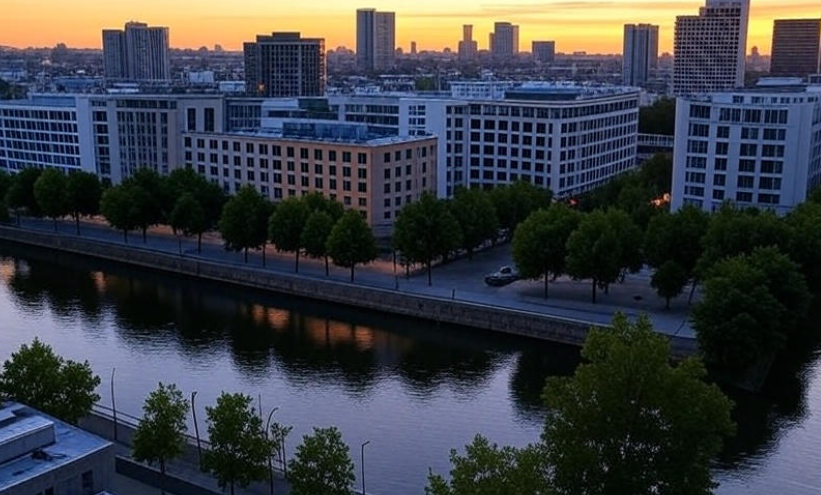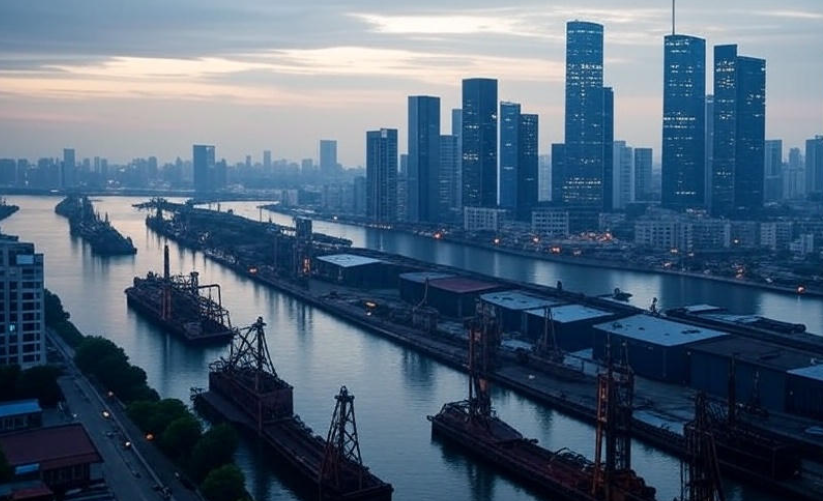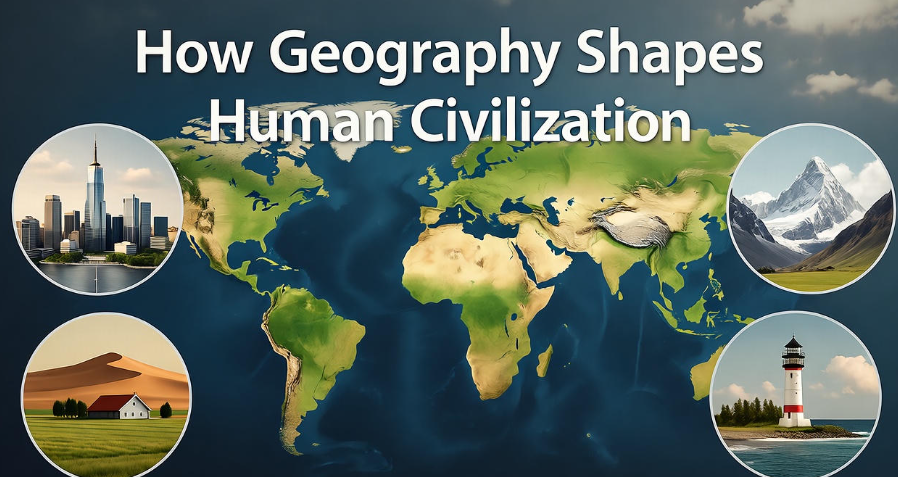The Earth we live on today looks very different from the one that existed thousands of years ago. Many of these changes are not caused by nature, but by humans. We’ve built cities, dams, farms, and roads almost everywhere. From space, scientists can even see how humans have reshaped the surface of our planet.
But how exactly are humans changing the geography of Earth? Let’s take a closer look.
Humans as a Geological Force
Long ago, nature was the main artist shaping Earth — rivers carved valleys, volcanoes built mountains, and glaciers molded plains. But in the last few hundred years, humans have become a major geological force. Some scientists even say we live in a new time period called the Anthropocene, meaning “the human age.”
We dig, burn, cut, and build on a massive scale. Every road, city, or mine is like a small scratch on the planet’s surface — and when you add them all up, the change is enormous.
Urbanization: The Rise of Concrete Landscapes
Cities are one of the biggest examples of how humans change geography. Urbanization turns natural land into built-up areas. Forests and farmlands are cleared to make space for housing, offices, and roads.
A few hundred years ago, most people lived in villages. Today, more than 56% of the world’s population lives in cities, and by 2050, it might reach 68%.
| Before Urbanization | After Urbanization |
|---|---|
| Forests, rivers, wildlife habitats | Concrete buildings, asphalt roads ️ |
| Natural water flow | Artificial drainage systems |
| Balanced temperature | Urban heat islands ️ |
| Biodiverse ecosystems | Reduced flora & fauna |
Cities also create “urban heat islands,” where temperatures are several degrees higher than nearby rural areas. Asphalt and concrete absorb sunlight, while trees that cool the air are often missing.
Deforestation and Land Clearing
Forests cover about 30% of the Earth’s surface, but every year, millions of hectares are cut down for agriculture, logging, and urban expansion.
Why it matters: Trees are natural protectors of soil and climate. When they’re removed, the land becomes more prone to erosion and flooding. Deforestation also releases carbon dioxide stored in trees, contributing to climate change.
In countries like Brazil, Indonesia, and parts of Africa, entire landscapes have been changed. What was once a dense rainforest is now farmland or pasture.
Agriculture: Reshaping the Land for Food
Farming might seem natural, but it’s actually one of the biggest ways humans modify land. To grow crops, we flatten hills, dig irrigation canals, and use fertilizers that change soil composition.
Agricultural terraces on hillsides prevent soil erosion but also change natural slopes. Massive irrigation systems, like those along the Nile or the Indus, have turned deserts into green farmland. However, overuse of water can cause salinization — when salt builds up in the soil, making it infertile.
| Positive Effects | Negative Effects |
|---|---|
| More food production | Soil erosion & loss of nutrients |
| Creation of jobs | Water shortages |
| Landscape beautification | Chemical pollution |
| Economic growth | Habitat loss for animals |
Mining and Extraction of Resources
Digging for gold, coal, oil, or rare earth metals doesn’t just remove materials — it literally removes pieces of the Earth’s crust.
In open-pit mining, entire mountains can disappear. The removed rock and soil are dumped elsewhere, forming artificial hills. The mining process can also contaminate rivers and groundwater with heavy metals.
For example, the Grasberg mine in Indonesia and the Bingham Canyon mine in the USA are so large that they’re visible from space. ⛏️
Dams and River Modification
Rivers used to flow freely, carving their own paths over time. But now, humans control many of them using dams. There are more than 57,000 large dams worldwide!
Dams provide electricity and water for cities, but they also stop natural sediment flow. This means that deltas — like the Nile or the Mekong — are shrinking because new soil isn’t reaching them anymore.
Downstream areas often face floods or droughts because of altered water flow. Some rivers, such as the Colorado River, no longer reach the ocean due to overuse.
| Benefits of Dams | Consequences |
|---|---|
| Hydropower ⚡ | Blocked fish migration |
| Irrigation support | Erosion of riverbanks |
| Flood control | Loss of wetlands |
| Tourism & recreation | Displacement of people |
Transportation and Infrastructure
Highways, railways, and airports connect people but also divide ecosystems. Roads cut through forests, creating “fragmented habitats.” This makes it hard for animals to move and find food or mates.
Construction of tunnels and bridges changes the physical shape of land. Even small infrastructure projects can change local drainage patterns and soil stability.
✈️ The spread of airports, for example, has led to coastal reclamation in cities like Hong Kong and Dubai, where the sea has been replaced with artificial land.
Climate Change and Melting Ice
Human activities like burning coal and oil release greenhouse gases, which trap heat in the atmosphere. This causes the planet to warm up — changing its physical geography in many ways.
The Arctic is melting faster than ever. As ice melts, sea levels rise, flooding low-lying islands and coastal cities. Entire regions, such as the Maldives or parts of Bangladesh, face the risk of disappearing under water.
In the mountains, melting glaciers affect river systems. People who depend on glacier-fed water are now seeing shortages.
️ Fun fact: The Greenland ice sheet is losing about 250 billion tons of ice each year — that’s enough to fill 100 million Olympic swimming pools!
Desertification and Soil Degradation
Over-farming, overgrazing, and deforestation can turn once-fertile land into dry, desert-like areas. This process is called desertification.
It’s not just about sand — desertification affects food security, water availability, and even migration. Areas in Africa’s Sahel region and parts of China are facing severe desert expansion.
The United Nations estimates that about 24 billion tons of fertile soil are lost every year due to unsustainable human activities.

Pollution and Waste Accumulation
When you throw something away, it doesn’t really go “away.” ️ Landfills, plastic waste, and industrial pollution are reshaping both land and oceans.
Mountains of trash now exist in many places — some, like the Great Pacific Garbage Patch, are floating in the sea and are larger than countries!
Toxic chemicals leak into the soil and water, changing the natural composition of ecosystems. Plastic pollution also changes coastlines, as debris builds up along shores.
Artificial Islands and Land Reclamation
Humans have even started making new land. Countries like the UAE, Singapore, and China have built artificial islands to expand their space. Dubai’s Palm Jumeirah and The World Islands are made of sand and rock taken from the sea.
These projects change ocean currents, affect marine life, and cause erosion elsewhere.
In some regions, land reclamation helps deal with overcrowding, but it often comes at an environmental cost.
Space Observation and Earth Changes
Satellites now show how human activities reshape Earth’s geography over time. Using satellite images, scientists can track how forests shrink, cities expand, and glaciers retreat.
This helps us understand the scale of human influence. For example, NASA’s Earth Observatory has shown that night-time city lights are spreading every year, while dark areas (natural landscapes) are shrinking.
Migration and Population Growth
More people means more demand for space, food, and water. Population growth drives urban sprawl, which pushes human settlements into forests, mountains, and coasts.
Migration caused by wars, climate change, and disasters also shifts where people live. Entire regions that were once empty now host large refugee populations, creating new towns and roads.
| Population Impact Example | Geographical Change |
|---|---|
| Rural-to-urban migration | Expansion of cities ️ |
| Climate refugees | New settlements on coasts |
| Overcrowding | Land reclamation projects |
| Industrial growth | Pollution & resource depletion |
Technology and the Digital Age
It may sound surprising, but even technology changes geography. Data centers, server farms, and energy-demanding industries require vast land and cooling water.
The construction of fiber-optic networks and 5G towers affects landscapes, while e-waste dumps create new “toxic geographies.”
Tourism and Recreational Activities
Tourism creates jobs and improves local economies, but it can also reshape landscapes. Mountains are cut for ski resorts, beaches are cleared for hotels, and coral reefs are damaged by excessive diving.
Famous sites like Mount Everest now face pollution from tourism — with tons of trash left behind by climbers.
Some areas even suffer from “overtourism,” where too many visitors destroy the very beauty they came to enjoy.
Steps Toward Restoration and Balance
Even though humans have caused many changes, there’s also hope. Reforestation, wetland restoration, and renewable energy projects are helping heal damaged lands.
Countries are creating protected areas and promoting eco-friendly farming. People are becoming more aware of their impact and taking small steps, like recycling and reducing plastic use.
| Restoration Efforts | Positive Outcomes |
|---|---|
| Tree planting campaigns | Improved air quality |
| Renewable energy use | Reduced carbon emissions |
| River clean-up projects | Healthier ecosystems |
| Sustainable farming | Fertile soil regeneration |
The Future of Earth’s Geography
If current trends continue, the map of the future may look very different. Coastlines could shift due to sea-level rise, deserts may expand, and forests could shrink further.
But the future isn’t set in stone. With careful planning and sustainable choices, we can slow down or even reverse some of these changes.
FAQs
Q1: Are humans really changing Earth’s geography that much?
Yes! From city building to deforestation and mining, humans have altered over 75% of the Earth’s land surface in some way.
Q2: What’s the most harmful human activity for geography?
It depends on the region, but deforestation, mining, and pollution are among the most damaging.
Q3: Can nature recover from human changes?
Yes, but it takes time. Forests can regrow, and rivers can clean themselves if pollution stops. Some areas recover faster with human help, such as reforestation or conservation programs.
Q4: How do satellites help us understand these changes?
Satellites give a “bird’s-eye view” of Earth, letting scientists monitor deforestation, melting ice, and city expansion over time.
Q5: What can we do to reduce our impact?
Small steps matter — use less plastic, save energy, plant trees, and support eco-friendly policies. Every action counts.
Final Thought
Humans have truly become Earth’s most powerful force of change. We’ve built amazing things, but also caused great damage. The question now isn’t just how we’ve changed the geography of Earth — it’s whether we can learn to live in harmony with it again.
Our planet is beautiful, but fragile. If we care for it today, it will care for us tomorrow.




